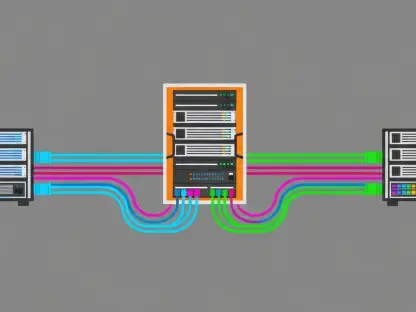Single-cell RNA sequencing (scRNA-seq) has fundamentally changed the landscape of biological research by providing an unparalleled view into gene expression at the individual cell level, revealing intricate details about cellular diversity across species, tissues, and developmental stages. With datasets ballooning from mere hundreds to millions of cells, the potential to decode complex biological systems is immense. Yet, integrating this vast amount of data across diverse samples, time points, and experimental conditions poses substantial challenges. Batch effects, which are technical variations arising from differences in experimental protocols or sequencing platforms, often obscure genuine biological signals, complicating accurate analysis. Traditional methods for batch correction, while useful for smaller datasets, frequently struggle with the scale and heterogeneity of modern single-cell data, failing to preserve subtle biological differences.
This pressing need for robust integration has spurred the adoption of deep learning approaches, particularly frameworks like variational autoencoders, which excel at handling high-dimensional data and learning complex patterns. These methods promise to disentangle technical noise from biological insights, offering scalability and adaptability that traditional tools lack. However, challenges remain, such as the risk of over-correction, where critical biological variations are lost in the quest to remove batch effects. Exploring how deep learning tackles these issues reveals a dynamic field ripe with innovation, from tailored loss functions to advanced benchmarking metrics, all aimed at enhancing the quality of single-cell data integration for groundbreaking biological discoveries.
Challenges in Single-Cell Data Integration
Batch Effects and Biological Signals
Batch effects stand as a formidable barrier in single-cell data integration, introducing technical variations that can mask the true biological differences essential for accurate scientific conclusions. These variations often stem from discrepancies in experimental setups, sequencing technologies, or sample handling, creating noise that distorts gene expression profiles. When left unaddressed, batch effects can lead to misinterpretations in analyses, such as clustering or differential expression studies, ultimately skewing research outcomes. The challenge lies not just in identifying these effects but in mitigating them without compromising the underlying biology, a task that demands precision and sophistication in methodology.
Equally critical is the preservation of biological signals, especially the subtle intra-cell-type variations that often hold key insights into disease states or developmental processes. Over-correction, a common pitfall in integration, risks stripping away these delicate differences, rendering datasets biologically incomplete. For instance, variations within a single cell type might indicate early disease markers or specific developmental stages, information that must be retained for meaningful analysis. Traditional statistical methods, while effective for broad batch correction, frequently fail to safeguard these nuances, underscoring the necessity for more advanced tools that can distinguish between noise and vital data.
Deep learning emerges as a promising solution to navigate this complex balance, leveraging its capacity to model intricate patterns within high-dimensional data, and unlike conventional approaches, deep learning frameworks can learn to separate technical artifacts from biological relevance, offering a pathway to cleaner, more reliable integrations. This capability is particularly vital as datasets grow in complexity, requiring methods that adapt to diverse sources of variation while ensuring that critical signals, especially within cell types, remain intact for downstream applications like disease research or cell atlas construction.
Scalability with Large Datasets
As single-cell datasets expand exponentially, often encompassing millions of cells, scalability becomes a pressing concern for integration efforts, especially since traditional statistical methods like Mutual Nearest Neighbors (MNN) or Harmony were designed for smaller datasets and often struggle under the computational load of modern data volumes. This limitation hampers their ability to process information efficiently, leading to bottlenecks in research workflows. The sheer size of contemporary datasets, combined with their inherent variability, demands tools that can operate at scale without sacrificing accuracy or speed, a challenge that is increasingly central to biological studies.
Deep learning methods offer a compelling solution to this scalability issue, thanks to their architecture that supports parallel processing and optimization for large-scale data. Frameworks like variational autoencoders are particularly adept at handling high-dimensional inputs, making them suitable for integrating massive single-cell datasets. Their ability to manage computational demands while maintaining performance is crucial for ambitious projects, such as constructing comprehensive cell atlases that map cellular diversity across organisms. This scalability ensures that researchers can keep pace with the rapid growth of data, facilitating timely and impactful discoveries.
Beyond computational efficiency, large datasets introduce greater batch variability, with differences in experimental conditions compounding across numerous samples. Integration methods must therefore adapt to increasingly complex batch structures, ensuring consistent performance regardless of data diversity. Deep learning’s robustness in this regard sets it apart, as it can learn and adjust to varied patterns of variation without requiring extensive manual tuning. This adaptability is key to maintaining biological fidelity in integrated data, enabling researchers to tackle expansive studies with confidence that the underlying science remains uncompromised by technical limitations.
Deep Learning Frameworks for Integration
Variational Autoencoders as Foundational Tools
Variational autoencoders, particularly conditional variants like scVI and scANVI, have become cornerstone tools in deep learning-based single-cell data integration, offering a robust means to manage the complexity of scRNA-seq data. These models work by learning latent representations that distill high-dimensional gene expression profiles into compact, meaningful embeddings. scVI, for instance, focuses on minimizing batch effects, creating unified data spaces where technical variations are diminished, thus providing a cleaner foundation for subsequent analyses such as clustering or trajectory inference. This ability to streamline data is invaluable for researchers aiming to extract reliable biological insights from noisy datasets.
Building on this, scANVI enhances the framework by incorporating cell-type labels into the integration process, prioritizing the preservation of biological identity alongside batch correction. By leveraging known annotations, scANVI ensures that distinct cell populations are maintained in the integrated data, improving the interpretability and relevance of results. This dual focus on reducing technical noise and maintaining biological fidelity makes these models highly effective for a range of applications, from basic research to clinical studies. Their design also allows for customization, enabling adaptation to specific research questions or dataset characteristics, which is a significant advantage in the diverse landscape of single-cell studies.
Moreover, the strength of variational autoencoders lies in their capacity to handle high-dimensional data with relative ease, a critical feature as single-cell datasets continue to grow in scale. Unlike traditional methods that may falter with millions of cells, these deep learning frameworks maintain robust performance, ensuring that large-scale studies are not hindered by computational constraints. This scalability, paired with their flexibility, positions them as indispensable tools for modern biological research, capable of supporting ambitious projects like mapping cellular diversity across entire organisms or uncovering disease mechanisms through integrated data analysis.
Role of Loss Functions in Model Performance
Loss functions serve as the guiding mechanism in deep learning models for single-cell integration, dictating how models optimize their performance during training to achieve desired outcomes. In the context of scRNA-seq data, these functions determine the delicate balance between eliminating batch effects and retaining biological information. For example, loss functions inspired by Generative Adversarial Networks (GANs) are particularly effective at creating uniform embeddings by focusing on the removal of technical variations, ensuring that data from different batches appears cohesive. This focus is essential for producing clean datasets suitable for broad analyses.
In contrast, other loss functions, such as Cell Supervised Contrastive Learning (CellSupcon), are tailored to prioritize biological conservation, ensuring that cell-type-specific information remains intact even under rigorous batch correction. These functions leverage known cell identities to maintain separation between distinct populations, preventing the loss of critical biological distinctions. However, an overemphasis on conservation can sometimes hinder batch effect removal, illustrating the need for careful design. The choice of loss function thus directly impacts the quality of integration, influencing whether the resulting data is biologically meaningful or overly homogenized.
Innovative loss functions, like Correlation Mean Squared Error (Corr-MSE), represent a significant step forward by addressing gaps in traditional approaches, particularly in preserving intra-cell-type structures. Corr-MSE focuses on maintaining correlation similarities within batches, safeguarding subtle variations that might indicate micro-populations or disease-specific states. This nuanced approach enhances overall integration performance, allowing researchers to retain fine-grained biological insights with only minimal trade-offs in batch correction. As such, the development and selection of loss functions remain a pivotal area of research, driving the evolution of deep learning methods to meet the complex demands of single-cell data integration.
Innovations in Benchmarking and Evaluation
Limitations of Existing Metrics
Benchmarking frameworks like scIB have been instrumental in evaluating the performance of single-cell integration methods, offering standardized metrics to assess batch correction and inter-cell-type conservation. However, a significant drawback lies in their limited scope, as they often fail to capture intra-cell-type variation—subtle differences within cell populations that can be crucial for specific studies. This oversight means that methods might score well on broad metrics but still lose vital biological information, leading to incomplete or misleading evaluations. Such a gap is particularly evident in complex datasets where deeper structures, beyond basic cell-type labels, play a critical role in analysis.
Additionally, existing metrics frequently struggle to account for multi-layer biological annotations, where data may include nested or hierarchical information about cell states. In datasets with rich annotations, such as those from the Human Lung Cell Atlas, discrepancies arise between broad conservation scores and the preservation of finer details. This mismatch can result in over-correction, where methods appear successful under conventional benchmarks but inadvertently erase important signals. The field is increasingly aware of these shortcomings, recognizing that a more comprehensive evaluation approach is necessary to truly gauge the effectiveness of integration strategies.
The implications of these limitations are far-reaching, as incomplete assessments can misguide method selection and optimization, ultimately affecting research outcomes. For instance, a method excelling in batch correction might be favored over one that better preserves intra-cell-type biology, skewing downstream analyses like differential abundance studies. Addressing this requires a shift toward metrics that encompass all dimensions of biological variation, ensuring that integration does not sacrifice depth for surface-level uniformity. This growing recognition is driving innovation in benchmarking, aiming to align evaluation with the nuanced needs of modern single-cell research.
Introduction of scIB-E and Corr-MSE
To overcome the constraints of traditional benchmarking, the extended framework scIB-E has been developed, offering a more holistic evaluation of single-cell integration methods by assessing performance across three distinct categories: batch correction, inter-cell-type conservation, and intra-cell-type conservation. This comprehensive approach ensures that methods are judged not only on their ability to unify data across batches but also on their capacity to retain both broad and subtle biological structures. New metrics within scIB-E, such as PCR comparison-batch and Jaccard index, specifically target intra-cell-type variation, providing a clearer picture of how well integration preserves fine-grained details critical to many biological inquiries.
Complementing scIB-E, the Correlation Mean Squared Error (Corr-MSE) loss function marks a notable advancement in deep learning for integration, focusing on maintaining correlation similarities within batches to safeguard intra-cell-type biological signals. Unlike earlier loss functions that might prioritize either batch correction or broad conservation, Corr-MSE strikes a balance by ensuring that subtle variations—often indicative of unique cellular states or disease markers—are not lost during the integration process. This innovation enhances the biological relevance of integrated datasets, making them more suitable for detailed downstream analyses where precision is paramount.
Initial results from applying scIB-E and Corr-MSE demonstrate their transformative potential in refining integration outcomes, offering a significant leap forward in single-cell data analysis. Methods evaluated under scIB-E reveal a more nuanced understanding of performance, highlighting areas where biological conservation can be improved without significant compromises in batch correction. Similarly, Corr-MSE has been shown to boost the retention of critical signals, with studies indicating modest trade-offs in technical noise reduction. Together, these tools pave the way for more accurate assessments, enabling researchers to select and optimize integration strategies that align with the complex demands of single-cell data, ultimately fostering deeper biological insights.
Biological Applications and Discoveries
Enhancing Downstream Analyses
The advancements in deep learning-based integration have profoundly impacted downstream analyses, particularly in techniques like differential abundance (DA) studies, which aim to detect shifts in cell populations under varying conditions. By prioritizing biological conservation alongside batch correction, these methods uncover nuanced cellular changes that traditional approaches might overlook. This enhanced resolution is crucial for understanding dynamic biological processes, such as immune responses or disease progression, where small population shifts can signal significant underlying mechanisms. The ability to detect such changes with greater accuracy transforms raw data into actionable insights, driving forward research in health and disease.
A compelling example lies in the application of advanced integration to datasets like the Human Breast Cell Atlas, where deep learning methods have revealed subtle cellular state changes associated with breast cancer risk factors. These findings, which include shifts linked to age or genetic mutations, highlight the practical value of preserving biological detail during integration. Such discoveries are not merely academic; they have real-world implications for identifying potential biomarkers or therapeutic targets, illustrating how refined integration can bridge the gap between data and clinical relevance. The precision offered by these methods ensures that critical signals are not lost amidst technical noise.
Moreover, the preservation of developmental trajectories represents another vital benefit of improved integration, especially in datasets like the Human Fetal Lung Cell Atlas. Deep learning frameworks ensure that temporal patterns of cell differentiation remain intact post-integration, providing a clearer view of how cells evolve over time. This capability is essential for developmental biology, where understanding the sequence of cellular changes can inform studies on congenital conditions or tissue engineering. By maintaining the integrity of these trajectories, deep learning enhances the reliability of analyses, enabling researchers to draw robust conclusions about biological progression and its disruptions.
Generalizability Across Diverse Datasets
Ensuring that deep learning methods for single-cell integration perform consistently across diverse datasets is fundamental to their adoption in biological research, as datasets vary widely in cell types, batch structures, and experimental contexts. Rigorous testing across a range of biological systems—from immune cells to pancreas, lung, and breast cell atlases—validates the robustness of these approaches. Methods like Domain Class Triplet Loss have demonstrated balanced performance, effectively managing batch correction while preserving biological information, regardless of the dataset’s origin or complexity. This consistency is a cornerstone for building trust in deep learning as a reliable tool for integration tasks.
Generalizability is not just a technical requirement but a practical necessity, as researchers need methods that can be applied broadly without extensive customization for each new dataset. Deep learning’s inherent adaptability aids significantly in this regard, allowing models to learn from varied inputs and adjust to different patterns of technical variation. This flexibility ensures that integration remains effective even when faced with datasets featuring unique challenges, such as sparse data or high batch variability. As single-cell research expands into new areas, such as rare disease studies or cross-species comparisons, the ability to generalize across contexts becomes increasingly critical.
Continued validation across diverse datasets also serves as a mechanism to refine these methods further, identifying potential weaknesses or areas for improvement. For instance, testing on datasets with differing levels of annotation depth can reveal whether methods overly rely on pre-labeled data, risking bias in unannotated scenarios. Such iterative evaluation helps developers optimize algorithms to handle emerging data types or experimental designs, ensuring long-term relevance. By fostering this cycle of testing and enhancement, deep learning solidifies its position as a versatile and dependable approach, capable of meeting the evolving demands of single-cell research across varied biological landscapes.
Future Horizons in Single-Cell Integration
Emerging Strategies and Multi-Omics Integration
The field of single-cell integration is witnessing a surge of emerging strategies that promise to push the boundaries of deep learning applications, particularly through techniques like reference-based mapping and contrastive learning. Reference-based mapping utilizes known datasets as guides to align new data, potentially improving the accuracy and consistency of integration by anchoring results to established biological frameworks. Meanwhile, contrastive learning focuses on distinguishing similar and dissimilar data points to refine latent representations, which could enhance the separation of technical noise from biological signals. These approaches signify a dynamic evolution, addressing nuanced challenges in data alignment and conservation.
Another frontier lies in multi-omics integration, where deep learning is poised to combine data from scRNA-seq with other modalities like ATAC-seq, which profiles chromatin accessibility. Integrating these diverse data types offers a more comprehensive view of cellular function, capturing both gene expression and regulatory mechanisms. However, this task introduces additional complexity, as each modality has unique characteristics and potential biases that must be harmonized. Deep learning’s ability to handle multi-dimensional data makes it well-suited for this challenge, but it requires specialized loss functions to ensure fair representation of each data type in the integrated output.
The development of tailored loss functions for multi-omics tasks is already underway, aiming to balance the contributions of different data sources while minimizing technical artifacts. These functions must account for disparities in data resolution or noise levels, ensuring that no single modality dominates the integration process. Successful multi-omics integration could revolutionize biological research, enabling holistic insights into cellular behavior that single-modality studies cannot achieve. As these strategies mature, they will likely redefine the scope of single-cell integration, expanding its utility in areas like personalized medicine or systems biology where multifaceted data is critical.
Building Comprehensive Cell Atlases
One of the most ambitious applications of enhanced single-cell integration is the construction of comprehensive cell atlases, which map cellular diversity across entire organisms or specific tissues with unprecedented detail. These resources are invaluable for basic research, providing a reference for understanding cellular composition, and for applied fields like drug discovery, where identifying target cell populations is key. Deep learning plays a pivotal role by ensuring that integrated data is free from technical artifacts, offering a clearer, more accurate depiction of biological reality. This clarity is essential for atlases to serve as reliable tools for scientific exploration and innovation.
Improved integration methods directly enhance the quality of cell atlases by preserving both broad cell-type distinctions and subtle intra-cell-type variations during data unification. For instance, maintaining fine-grained differences within a cell population can reveal rare subtypes or disease-specific states, enriching the atlas’s utility for targeted studies. Deep learning’s capacity to scale with large datasets also supports the creation of expansive atlases, handling the integration of millions of cells from diverse sources without loss of fidelity. This scalability ensures that atlases remain comprehensive and up-to-date as new data is incorporated over time.
Furthermore, the ongoing push for standardization in integration metrics, such as those introduced by scIB-E, aids in building trust in cell atlases by ensuring consistency across studies. Standardized evaluation helps confirm that integrated data within an atlas meets rigorous quality thresholds, fostering confidence among researchers who rely on these resources. As deep learning continues to refine integration processes, the resulting atlases will become increasingly precise, serving as foundational platforms for advancing biological knowledge. This progress underscores the transformative potential of deep learning in turning vast, complex datasets into structured, accessible insights for the global research community.
Reflecting on Progress and Next Steps
Lessons from Past Innovations
Looking back, the journey of single-cell data integration revealed persistent struggles with batch effects that clouded biological signals, a challenge that traditional statistical methods like Mutual Nearest Neighbors often couldn’t fully resolve. These early tools, while groundbreaking at the time, struggled with the scale and diversity of emerging datasets, frequently sacrificing subtle biological variations in favor of broad technical corrections. The limitations became evident as datasets grew, highlighting a gap that spurred the adoption of more sophisticated approaches to address both technical noise and biological fidelity.
The rise of deep learning, particularly through frameworks like variational autoencoders, marked a turning point, offering scalability and adaptability that transformed how integration was approached. Models such as scVI and scANVI demonstrated an unprecedented ability to disentangle complex data patterns, setting new standards for preserving critical information. Innovations like the Corr-MSE loss function further refined this balance, ensuring intra-cell-type structures remained intact, while extended benchmarking with scIB-E provided a clearer lens to evaluate success across multiple dimensions. These advancements underscored a shift toward comprehensive solutions tailored to the nuances of single-cell research.
Pathways for Future Advancement
Moving forward, the focus should center on refining deep learning frameworks to tackle emerging challenges, such as integrating multi-omics data for a fuller picture of cellular function. Developing specialized loss functions and model architectures that adapt to diverse data modalities will be crucial, ensuring that integration captures the interplay of gene expression, epigenetics, and beyond. Collaborative efforts between biologists and data scientists can drive these innovations, aligning technical capabilities with biological relevance to address real-world research needs.
Additionally, enhancing accessibility to these powerful tools stands as a priority, with user-friendly platforms and pre-trained models lowering barriers for researchers lacking deep computational expertise. Establishing standardized benchmarks, building on existing frameworks, is also crucial to ensure consistency and reliability in research outcomes.









